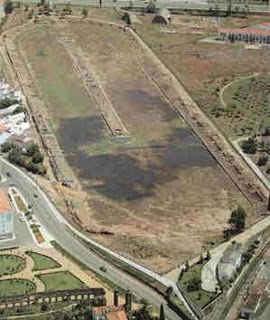circus

Circus of Emerita. It measures 440 m long by 115 m wide. The stands were built for 30,000 spectators.
In ancient Rome, a circus was a large oblong arena for public entertainment. Events in the circus included chariot races, athletic games, battles between gladiators, mass executions, aquatic spectacles, and wild beast hunts.
Origins of the Roman circus
The Circensian Games were alleged by tradition to originated in the time of Romulus; and Tarquinius Priscus celebrated a notable victory by games. The games continued to be held annually, and a permanent edifice was afterwards constructed. This was distinguished, subsequent to the erection of the Flaminian and other large circi, as the Circus Maximus.
The Circus Maximus
The Circus Maximus must have been altered and enlarged at various times. Dionysius says it could hold 150,000 people; Pliny 200,000; and P. Victor 350,000. Its extent also has been variously estimated. In the time of Julius Caesar it was three stadia or 1,875 feet long, and one stadium or 625 feet wide, while the depth of the buildings surrounding the open space was half a stadium, or about 312 feet. The plan was oblong, rounded at one end and square at the other. Along the sides and at the curved end were ascending ranges of stone seats for the spectators. At the other end were the carceres or stalls in which the horses and chariots were kept, until, on a given signal, the gates were opened simultaneously. In the center was the spina a long, broad wall round which the charioteers drove, terminating at both ends at the metae or goals – conical pillars which marked the turnings of the course. Julius Caesar made a euripus or canal round the course to protect the spectators during the staged conflicts of wild animals.
Uses of the circus
The circus was especially adapted for chariot races, an amusement of which the Romans were passionately fond. The length of a race was seven circuits round the spina, and 25 races were held each day. The number of chariots was usually four. The athletic competitions, such as boxing and wrestling, sometimes ended fatally. A regular battle was sometimes represented (Pugna Equestris et Pedestris). By the formation of the canals and the introduction of vessels, a Naumachia, or sea-fight, was occasionally exhibited; but, under the empire, this type of display, as well as the Venatio, was gradually transferred to the Amphitheatre. Animals for the Venatio or hunting were procured from every available part of the Roman empire, including Asia and Africa. The exhibition not only gave the chance to show off personal wealth or ostentation, but was an important way for individuals to attain political power. Doles of bread and circuses (panem et circenses) were often demanded by the populace from candidates. When Pompey opened his new theater he is said to have given public exhibitions in the circus for five days, during which 500 lions and 20 elephants were destroyed. The Greek hippodrome was very similar in its arrangements to the Roman circus.
